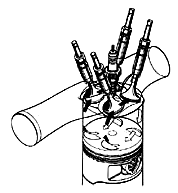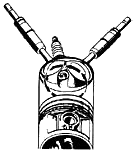







































General Overview
 This website is about combustion chamber design. For a description of a
combustion chamber go to Definition of Combustion Chamber. This
website discusses combustion chambers in internal combustion engines. There are
two main types of internal combustion engines:
spark ignition engines and compression ignition engines. Spark ignition
engines have spark plugs, which produce a flame that is used to ignite the fuel.
Compression ignition engines compress the air and fuel mixture inside the
cylinder to a pressure and temperature at which the mixture will ignite. This
website will focus on the spark ignition engine since these engines are more
common in passenger cars. These chambers come in a wide variety of
configurations. To see some common configurations go to Combustion Chamber Shapes.
This website is about combustion chamber design. For a description of a
combustion chamber go to Definition of Combustion Chamber. This
website discusses combustion chambers in internal combustion engines. There are
two main types of internal combustion engines:
spark ignition engines and compression ignition engines. Spark ignition
engines have spark plugs, which produce a flame that is used to ignite the fuel.
Compression ignition engines compress the air and fuel mixture inside the
cylinder to a pressure and temperature at which the mixture will ignite. This
website will focus on the spark ignition engine since these engines are more
common in passenger cars. These chambers come in a wide variety of
configurations. To see some common configurations go to Combustion Chamber Shapes.
The thermal and fluid aspects involved in the design of the
combustion chamber will be included. These aspects must be accounted for in the design considerations of a combustion chamber. The design
considerations for a combustion chamber include fast combustion, volumetric
efficiency, heat loss and flow in a cylinder. For more information on these
design considerations go to Design
Considerations.
accounted for in the design considerations of a combustion chamber. The design
considerations for a combustion chamber include fast combustion, volumetric
efficiency, heat loss and flow in a cylinder. For more information on these
design considerations go to Design
Considerations.
 In
general, several findings were made utilizing these design consideration. It was
discovered that the combustion chamber must have certain features in order to
yield an engine with maximum performance and efficiency. An optimal chamber
should have large valve heads to ensure a high volumetric efficiency. The
chamber must minimize heat loss to produce a rapid combustion. A central spark
plug location will help produce this rapid combustion. Sufficient turbulent flow
must be present to mix the air-fuel mixture in order to help prevent knocking
and decrease the combustion time. For more details, click on the related links.
In
general, several findings were made utilizing these design consideration. It was
discovered that the combustion chamber must have certain features in order to
yield an engine with maximum performance and efficiency. An optimal chamber
should have large valve heads to ensure a high volumetric efficiency. The
chamber must minimize heat loss to produce a rapid combustion. A central spark
plug location will help produce this rapid combustion. Sufficient turbulent flow
must be present to mix the air-fuel mixture in order to help prevent knocking
and decrease the combustion time. For more details, click on the related links.